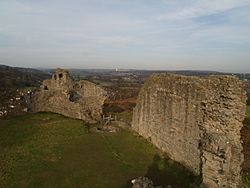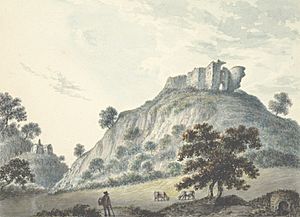Caergwrle Castle facts for kids
Quick facts for kids Caergwrle Castle |
|
|---|---|
| Caergwrle, Flintshire in Wales | |

Ruins of Caergwrle Castle with town of Caergwrle below
|
|
| Coordinates | 53°06′26″N 3°02′14″W / 53.107290°N 3.037164°W |
| Type | Castle |
| Site information | |
| Condition | Ruins remaining. |
| Site history | |
| Built | Approx 1277 |
| Materials | Stone |
| Fate | Destroyed following fire. |
Caergwrle Castle (Welsh: Castell Caergwrle), sometimes known as Queen's Hope, is an old castle located in the town of Caergwrle, in Flintshire, Wales. It was first built by the Welsh leader Dafydd ap Gruffydd around 1277, working for King Edward I of England.
When Dafydd's forces rebelled against the English, Edward sent his army to take the castle in 1282. But Dafydd had already left and damaged the castle on purpose. Edward I then started rebuilding it and gave it to his wife, Eleanor of Castile. A new town was planned near the castle, but this idea was stopped after a big fire in 1283. Both Edward and Eleanor were at the castle when the fire happened. The castle was passed down through the royal family, but it was never fully rebuilt. Today, only ruins remain. In 1823, a special Bronze Age pot called the Caergwrle Bowl was found near the castle.
Contents
What Does Caergwrle Castle Look Like?
Caergwrle Castle was built on a steep hill near the border between England and Wales. From the castle, you could see far into the area of Cheshire. The castle's base was made from a type of stone called gritstone. This stone was dug up from Caergwrle hill, which is close by.
You can see two different building styles in the castle's stone walls. The fancier work was done in the living areas and on the outside walls. Inside, the walls would have been covered with plaster. This meant that the detailed stone work would not have been seen.
Today, the western outer wall, called a curtain wall, is gone. Most of the southern tower is also missing. The rock under the south tower is also gone. This might be because people dug for stones very close to the castle. The hilltop was known for being a place where people dug for stones to make millstones in the 1600s.
After the castle was damaged, people took stones from it. Some walls are missing big stones, showing that people took them one by one. But large parts of the castle are completely gone. This suggests that many stones were taken, perhaps for other buildings. Historians think the west wall and most of the south tower were removed this way. It would have been easier to take them apart and roll the stones down the steep hill.
A Look at the Castle's Past
Before the stone castle we see today, there might have been an older fort on the hill. This fort could have been there during Roman times or just after.
Building the Castle
The building of the stone castle began in 1277. This was after King Edward I of England won wars against the Welsh. As a reward for his help in these wars, Edward gave the area of Hope to Dafydd ap Gruffydd. Dafydd was the brother of Llywelyn the Great, another important Welsh leader. Dafydd had fought against Llywelyn because Llywelyn had put him in prison.
The first mention of the castle is in royal records from 1278. It says that King Edward sent money to Dafydd for the castle. Some experts debate if this money was for starting the castle or for keeping it in good shape. The castle had two D-shaped towers and a large round keep (main tower). This keep looked over the path leading to the castle from the southeast.
Some people think Dafydd hired English builders to work on the castle. It seems the castle was not finished when Dafydd rebelled against Edward in 1282. King Edward gathered an army to invade Wales in June. He sent Reginald de Grey, 1st Baron Grey de Wilton to capture Caergwrle Castle. When Reginald's army arrived on June 16, they found that Dafydd had already left. He had also damaged the castle on purpose.
The Castle's Short Life
The Welsh had damaged the castle, even blocking up its well. Over the next 14 weeks, Reginald worked to fix the castle. He kept detailed notes, showing that it cost a lot of money to repair. King Edward himself might have been there for a few days to guide the architect, James of Saint George, on the repairs. More than 340 carpenters and over 600 diggers helped fix the castle. Also, 30 to 35 stone masons worked on Caergwrle Castle every week from June to November. Many wooden buildings were also built at this time, including a chapel and a bakery.
In February 1283, Edward gave Caergwrle Castle to his wife, Eleanor of Castile. Reports say that the walls were still covered. This means the work on them was not finished when Eleanor received the castle. A new town was planned to be built at the bottom of the castle. In June of that year, Eleanor was allowed to have a weekly market in the new town. The idea was for English settlers to live there.
However, an accidental fire broke out in the castle on August 27, 1283. King Edward and Queen Eleanor were both there when it happened.
What Happened Next?
After the fire, the damaged castle was given to Edward of Caernarfon (who later became Edward II of England). But he did not make any repairs. When Edward II became king, he gave the castle to John of Cromwell for his lifetime. The deal was that John would repair it. However, historians doubt that any repairs were made. After John's death, the castle was given to Edward, the Black Prince. He noted that the walls and towers were in ruins, and there were no houses there. Caergwrle Castle was the last castle built by Welsh rulers before Wales lost its independence.
The Caergwrle Bowl
The Caergwrle Bowl is a very old pot from the Bronze Age. It was found by a worker digging a drain in the fields below the castle in 1823. It is special because it is made of shale, tin, and gold.
Between 1988 and 1990, archaeologists dug at the castle site. They focused on the ground inside the walls and the three towers that were still standing. Today, the ruins of Caergwrle Castle are looked after by the Caergwrle Community Council. It is a very important historical site, listed as a Grade I listed structure.



